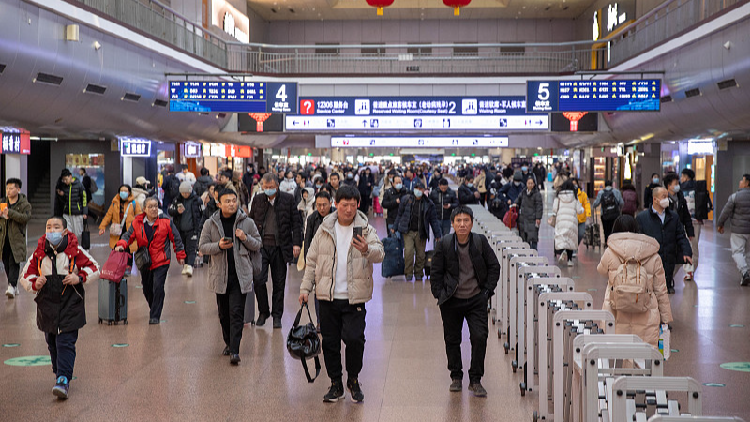Uncovering New Layers of the Chinese Spring Festival: More than Just a Homecoming
Chinese Spring Festival: beyond homecoming

Editor's note: Liu Xiangyan is an associate researcher and Ma Xiaofen is a postdoctoral fellow of the Institute of International Studies at China Tourism Academy. The article reflects the author's opinions and not necessarily the views of CGTN.
The Spring Festival is a traditional Chinese holiday for family reunions and homecomings. Every year, the arrival of the Lunar New Year triggers the so-called Spring Festival travel rush, or Chunyun in Chinese, which will last 40 days from 26 January to 5 March this year. As estimated by China’s Ministry of Transport, passenger flow during this period is projected to reach a historic high, totaling approximately nine billion passenger trips, with self-driving accounting for around 80 percent of the total.
Long-distance inter-provincial travel is expected to increase significantly. The transportation network will continue to grapple with high-demand challenges, with concerns such as "difficulties in securing railway tickets" and "slow-moving traffic on the highways" persisting during the peak days of homecoming and return to work, remaining the primary sources of apprehension. To address these challenges, China Railway Group and various airlines are increasing the number of trains and flights. During the 40-day Spring Festival travel season, the daily seating capacity of trains is expected to grow by double digits compared to the 2019 season. The average daily number of flights is anticipated to increase by over 20 percent compared to 2023.
As people's tourism preferences and experiences evolve, the traditional practice of exclusively returning home for this grand holiday is no longer the sole focus. An increasing number of individuals opt to celebrate the Spring Festival by traveling to various destinations, creating cherished moments with their families through enjoyable leisure activities. As a result, an escalating trend among travelers is the preference for the "Visit Family + Tourism" model, which involves combining family visits with tourism experiences. According to the "2024 Spring Festival Travel Trend Report" by Tongcheng Travel, there will be a significant increase projected in family travel. Data from Fliggy also indicates that the overall search interest for holiday travel has surpassed the levels observed during the same period in 2019.
When selecting travel destinations, a diverse range of preferences has been exhibited. Main tourist destinations are anticipated to be first and second-tier cities, which are well-suited to fulfill the requirements of family travel. In a departure from previous years, this increased influx of visitors has brought a vibrant atmosphere to major cities like Beijing, Shanghai, Guangzhou, and Shenzhen. These urban centers, which typically experience a quiet spell during the Lunar New Year due to the departure of large amount of residents to their hometowns, are now bustling with activity.
At the same time, the trend of exploring alternative travel destinations continues to heat up. According to Baidu Index data, searches for "affordable and off-the-beaten-path" travel during the Spring Festival have surged, highlighting that cost-effectiveness remains a primary consideration for the general public when planning their trips. The "North-South Counterflow" trend persists due to the distinctive cold and warm climate advantages in the northern and southern regions during winter. Southerners are heading to places like Harbin City to indulge in snow and ice activities, while northerners are opting for destinations such as Hainan Island to bask in the warm sunshine.
New travel formats and innovations in destinations have the potential to emerge as unexpected successes. To attract travelers, numerous destinations are introducing specialized railway tourism routes and distinctive cultural and tourism experiences during the Spring Festival, such as Lunar New Year markets, firework displays, and parades. Travel guidance for the Spring Festival holiday is disseminated through major travel and social platforms such as Ctrip, Mafengwo, Xiaohongshu, Douyin, etc. Additionally, travel gatherings organized on these platforms have significantly diversifed people's travel preferences, destinations, and activity choices.
Travel distances are also expanding during the relatively extended 8-day Spring Festival holiday, allowing people to explore destinations abroad. Thanks to visa-free policies implemented by numerous international destinations for Chinese travelers and the substantial decrease in international airfare prices, there is a noticeable trend indicating a great increase in outbound tourism. Data from Fliggy revealed that outbound tourism has reached a peak unseen in nearly four years, with booking volumes increasing over 15 times compared to the previous year. Additionally, there will be a significant extension in the distance of outbound travel. A report from Tongcheng Travel highlighted that favored outbound destinations for the Spring Festival are mainly centered in Southeast Asia, with destinations like Thailand and Malaysia gaining significant popularity. Long-haul destinations such as the UAE, Australia, and Northern Europe have also emerged as popular choices for outbound travel.
(Cover via CFP)
IS TROIB News
Find more stories on Business, Economy and Finance in TROIB business












